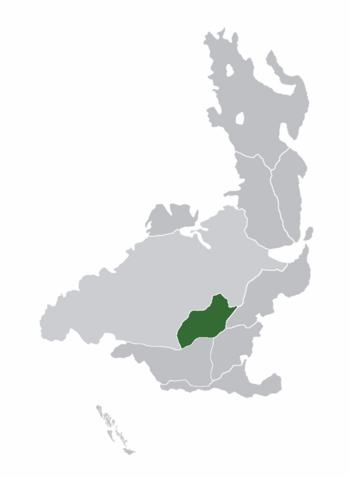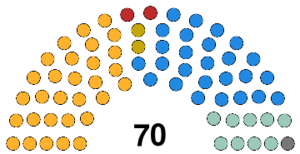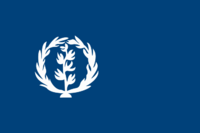Difference between revisions of "Uulgadzar"
m (→Mining) |
|||
| Line 50: | Line 50: | ||
|religion_ref = <!--(for any ref/s to associate with religion data)--> | |religion_ref = <!--(for any ref/s to associate with religion data)--> | ||
|demonym = Uulgadzan <!--Term/s describing those associated with the country/territory (e.g. "Belgian" for the country Belgium)--> | |demonym = Uulgadzan <!--Term/s describing those associated with the country/territory (e.g. "Belgian" for the country Belgium)--> | ||
| − | |government_type = [[Wikipedia:Devolution|Devolved]] [[Wikipedia:Unitary state|unitary]] [[Wikipedia:Semi-presidential system|semi-presidential]] republic | + | |government_type = [[Wikipedia:Devolution|Devolved]] [[Wikipedia:Unitary state|unitary]] [[Wikipedia:Semi-presidential system|semi-presidential]] republic <!--(often a compound multi-wikilinked term, e.g. "Federal semi-presidential constitutional republic", etc)--> |
| − | |leader_title1 = | + | |leader_title1 = President <!--(for a country, usually the head of state's (wikilinked) title, e.g. "President", "Monarch")--> |
| − | |leader_name1 = | + | |leader_name1 = ''Position vacant'' |
| − | |leader_title2 = | + | |leader_title2 = Prime Minister <!--(could be "Vice President", otherwise "Prime Minster", etc, etc)--> |
| − | |leader_name2 = | + | |leader_name2 = ''Position vacant'' |
|leader_title3 = | |leader_title3 = | ||
|leader_name3 = | |leader_name3 = | ||
| Line 135: | Line 135: | ||
|footnotes = <!--For any generic non-numbered footnotes--> | |footnotes = <!--For any generic non-numbered footnotes--> | ||
}} | }} | ||
| − | '''Uulgadzar''' ([[Uulgadzan language|Uulgadzan]]: ''Уулгазар'' [ʊʊɮɡatsar]), officially the '''Uulgadzar Republic''' ([[Uulgadzan language|Uulgadzan]]: ''Бүгд Найрамдах Уулгазар Улс'' [pukt nɛːramtax ʊʊɮɡatsar ʊɮs]) is a land-locked devolved | + | '''Uulgadzar''' ([[Uulgadzan language|Uulgadzan]]: ''Уулгазар'' [ʊʊɮɡatsar]), officially the '''Uulgadzar Republic''' ([[Uulgadzan language|Uulgadzan]]: ''Бүгд Найрамдах Уулгазар Улс'' [pukt nɛːramtax ʊʊɮɡatsar ʊɮs]) is a land-locked devolved unitary semi-presidential republic in [[Ostlandet]]. It is bordered by [[Estcharia]] to the west, [[Mediternia]] to the northwest, [[Zloveshchiy]] to the east, [[Gjorka]] to the southeast, and [[Ajakanistan]] to the south. It is well-known for its sprawling steppe and "shining" mountains. Uulgadzar has a land area of TBD. Its total population, according to the 2020 census, is 4,926,306. Its capital and largest city is [[Uulhot]]. |
| − | The Uulgadzan people first arrived in the area of modern Uulgadzar in about 4000 BCE. Permanent settlements first began in about 400 CE, with the first united nation of Uulgadzan people being formed in around 670 CE, being named the Union of Uul. In 1593, the Mountain Wars erupted between the Uulgadzan Kingdom and TBD. After the Mountain Wars, the borders of Uulgadzar remained mostly unchanged for the rest of its history. In 1978, the Silent Coup abolished the monarchy and created a more open democracy in Uulgadzar. In 1979, the Uulgadzar Republic was formed | + | The Uulgadzan people first arrived in the area of modern Uulgadzar in about 4000 BCE. Permanent settlements first began in about 400 CE, with the first united nation of Uulgadzan people being formed in around 670 CE, being named the Union of Uul. In 1593, the Mountain Wars erupted between the Uulgadzan Kingdom and TBD. After the Mountain Wars, the borders of Uulgadzar remained mostly unchanged for the rest of its history. In 1978, the Silent Coup abolished the monarchy and created a more open democracy in Uulgadzar. In 1979, the Uulgadzar Republic was formed. |
Since 1990 the quality of life and quality of education in Uulgadzar has improved. A study in 2011 showed that the average Uulgadzan person would receive 3 more years of education in 2010 than they would have in 1990. The percentage of college graduates in the nation rose from 19.5% in 1985 to 68.9% in 2015. The nation's main exports are minerals, particularly copper, gold, coal, and uranium. Recently, there have been investments into producing natural gas via coalbed methane extraction. It is a secular state, however most people in Uulgadzar follow a religion, according to the 2020 census. | Since 1990 the quality of life and quality of education in Uulgadzar has improved. A study in 2011 showed that the average Uulgadzan person would receive 3 more years of education in 2010 than they would have in 1990. The percentage of college graduates in the nation rose from 19.5% in 1985 to 68.9% in 2015. The nation's main exports are minerals, particularly copper, gold, coal, and uranium. Recently, there have been investments into producing natural gas via coalbed methane extraction. It is a secular state, however most people in Uulgadzar follow a religion, according to the 2020 census. | ||
Revision as of 13:27, 12 July 2023
Uulgadzar Republic | |
|---|---|
Motto: Бид хаана байх, бид явах Bid khaana baikh, bid yavakh "Where we stay, we go" | |
Anthem: Уулгазар улсын төрийн дуулал Uulgadzar ulsyn töriin duulal "National Anthem of Uulgadzar" | |
 Location of Uulgadzar in Ostlandet | |
| Capital and | Uulhot |
| Official languages | Uulgadzan |
| Recognised national languages | Stepadnó |
| Ethnic groups (2020) | 82% Uulgadzan 16% Stepadnó 2% Other |
| Religion (2020) | 67.9% Naršoroo 16.1% Christian 9% Atheist/Agnostic/No religion 7% Other |
| Demonym(s) | Uulgadzan |
| Government | Devolved unitary semi-presidential republic |
• President | Position vacant |
• Prime Minister | Position vacant |
| Legislature | Ardbayshin |
| Formed by union of various tribes | |
• Formation of Union of Uul | 670 CE |
• Mountain War | 1593 |
• Silent Coup | 1978 |
• Proclamation of Uulgadzar Republic | 1978 |
| Area | |
• | 535,360 sq mi (1,386,600 km2) |
| Population | |
• 2022 estimate | 5,100,026 |
• 2020 census | 4,926,306 |
| GDP (nominal) | 2020 estimate |
• Total | ₵65,315,300,000 |
• Per capita | ₵6,531.53 |
| Gini (2020) | 39.8 medium |
| HDI (2020) | high |
| Currency | Uulgadzan tögrög (UUT) |
| Time zone | AMT+11 (UGT) |
| Mains electricity | 120 V-60 Hz |
| Driving side | right |
| Calling code | +77 |
| Internet TLD | .uu |
Uulgadzar (Uulgadzan: Уулгазар [ʊʊɮɡatsar]), officially the Uulgadzar Republic (Uulgadzan: Бүгд Найрамдах Уулгазар Улс [pukt nɛːramtax ʊʊɮɡatsar ʊɮs]) is a land-locked devolved unitary semi-presidential republic in Ostlandet. It is bordered by Estcharia to the west, Mediternia to the northwest, Zloveshchiy to the east, Gjorka to the southeast, and Ajakanistan to the south. It is well-known for its sprawling steppe and "shining" mountains. Uulgadzar has a land area of TBD. Its total population, according to the 2020 census, is 4,926,306. Its capital and largest city is Uulhot.
The Uulgadzan people first arrived in the area of modern Uulgadzar in about 4000 BCE. Permanent settlements first began in about 400 CE, with the first united nation of Uulgadzan people being formed in around 670 CE, being named the Union of Uul. In 1593, the Mountain Wars erupted between the Uulgadzan Kingdom and TBD. After the Mountain Wars, the borders of Uulgadzar remained mostly unchanged for the rest of its history. In 1978, the Silent Coup abolished the monarchy and created a more open democracy in Uulgadzar. In 1979, the Uulgadzar Republic was formed.
Since 1990 the quality of life and quality of education in Uulgadzar has improved. A study in 2011 showed that the average Uulgadzan person would receive 3 more years of education in 2010 than they would have in 1990. The percentage of college graduates in the nation rose from 19.5% in 1985 to 68.9% in 2015. The nation's main exports are minerals, particularly copper, gold, coal, and uranium. Recently, there have been investments into producing natural gas via coalbed methane extraction. It is a secular state, however most people in Uulgadzar follow a religion, according to the 2020 census.
Contents
Etymology
Uulgadzar (уулгазар) comes from uul (уул) meaning mountain and from gadzar/gazar (газар) meaning ground or land. The two words were separated formally until the 19th century, when the nation's name was changed from Uul Gadzar to Uulgadzar. However, informally the words had been united as early as the 17th century.
History
Prehistory
The ancient Uulgadzan people first arrived in the area that is now Uulgadzar in about 4000 BCE. Very little is known about these people. They were mostly nomadic and domesticated horses.
The first Stepadnó people arrived in the area that is now east Uulgadzar around 2500 BCE. Ancient cave drawings from the area the Stepadnó were believed to inhabit show some people- most likely Uulgadzans- attacking their primitive villages.
Tribal era
It is believed that some ancient Uulgadzan groups settled down around 1000 BCE, during the advent of writing in Uulgadzar. Most of these settlements have been lost to time, however some buildings have been excavated and some of these villages have lasted through time, like the now-capital of Uulgadzar, Uulhot.
During the tribal era, the first large-scale structures were created as religious buildings. One of the largest structures was discovered near Altanövs in 1964 during an archaeology expedition where one of the locals reported a building sticking out of the ground after a drought. The structure is believed to be a building dedicated to Naršoroo.
During the late tribal era, around 300-600 CE, it is believed that the first skirmishes between the Uulgadzan people and the Stepadnó erupted. It is also believed that the raids on Stepadnó villages ended around this time.
Union of Uul
The Union of Uul formed in 670 CE when the two dominant tribes, Uul and Hoyd (хойд), merged in a union between the two tribal leaders. They controlled about a third of modern Uulgadzar, with the rest being controlled by hundreds of minor Uulgadzan tribes and the Stepadnó.
The vast majority of people in the Union of Uul were nomadic, so the governmental structure was very unstable and they lacked strong control over their land. A program instituted by the military of the Union of Uul forced people into the villages so the government could control them and keep track of them easier.
The smaller Uulgadzan tribes had almost all been consolidated into the Union of Uul by the early 16th century. At this point, the Union of Uul controlled about two-thirds of modern Uulgadzar. The remainder was controlled by the Stepadnó Kingdom, which at this time was building up a large army most likely for the invasion of the Union of Uul.
Mountain War
The Mountain War began when the Stepadnó began the Siege of Khushir with no provocation. The siege lasted for 11 days when the army of the Union of Uul, now named Uul Gadzar or Uulgadzar, pushed the Stepadnó away from the city and back to the quaint village of Kosaka.
Over the next 5 years, the Mountain War raged on until the Battle of Shinemori where the Uulgadzans decisively defeated the Stepadnó and forced them to sign a treaty forcing them to integrate into Uulgadzar. Ever since, the borders of Uulgadzar have been mostly unchanged.
20th century
In the late-19th century, rapid urbanization and industrialization brought Uulgadzar to the world stage into the 20th century. In 1923, the chieftain of Uulgadzar was ousted to make way for a new communist government inspired by the Ajaki Civil War of 1900.
The communist government made several dozen attempts to move the mostly agrarian population into cities. However, these all failed except for one in 1936. It was able to convince about 200,000 Uulgadzans and Stepadnó to move into cities after the Great Drought of 1935.
In the mid-1950s, unrest from the Stepadnó reached its tipping point after the pacification actions in Stepadnó in the 1940s and early-1950s. Large-scale protests erupted across the nation, however most were suppressed by the communist government. These protests calmed down during the 1960s, but erupted again in the 1970s during the Second Ajaki Civil War. The protests called into question the benefits of communist governance. The protests reached their climax on July 2nd, 1978 in the Shinemori Massacre where riots in the Stepadnó Red Square led to the communist government executing 2,000 people who were mostly Stepadnó under the age of 21.
Silent Coup and Uulgadzar Republic
On July 13th, 1978 at 8:05 am, the Vice-Chairman of the Communist Party at the time, Alchidai Ligdan, poisoned Galdan Khal, the Chairman of the Communist Party, killing him and kicking off the 1978 Uulgadzan coup d'état, commonly referred to as the "silent coup". Over the next hour, most high-ranking party members that did not support Ligdan's agenda or were still loyal to Khal were executed or fled.
That night at 11:36 pm, the democratic Uulgadzar Republic was proclaimed, ending the era of communist rule in Uulgadzar. The removal of the communist government was appreciated by most, especially the Stepadnó who had suffered under communist rule and farmers who had been neglected for unprofitable factories in urban areas.
Late 20th century and 21st century
After the Silent Coup, time was spent demilitarizing the bloated Uulgadzan military created by the communist regime. Focus was put on farms instead of factories, and the first elections in Uulgadzan history were held. The nation's GDP per capita and HDI increased immensely over the 1990s and 2000s.
In 2004, the government of Uulgadzar apologized to the Stepadnó people for the actions of the communist government in the 1940s. Ever since, there has been minimal tension between the two groups.
Geography and Climate
Uulgadzar contains a mix of temperate, semi-arid, and arid climates. In the south and north-west, semi-arid steppe climate dominates, causing hot temperatures with little rain. In the west, the Dogšin Desert has a predominately arid climate, with temperatures rarely, if ever, reaching below freezing, and nearly no rain. It is the most sparsely populated place in Uulgadzar. In the east, a temperate climate exists. It is separated from the semi-arid and arid climates by the Uulgadzar Mountains.
Politics
Government
Uulgadzar is a devolved unitary semi-presidential republic under a de jure substantive democracy. The nation's president serves as the head of state and the prime minister as the head of government. The president is voted on directly by the people, and appoints a prime minister.
Legislature
The legislative branch of Uulgadzar operates on a unicameral parliament named the Ardbayshin. The parliament, consisting of 70 seats, has one seat for every district, as well as one seat for each of the eleven provinces. The last elections took place on March 27, 2023, so the next elections will take place on March 27, 2025.
 | |||||
|---|---|---|---|---|---|
| Party | Abbr | Ideology | Seats | ||
| Uulgadzar Forward | Social democracy | ||||
| Together Uulgadzar | Liberal conservatism | ||||
| Neg-gadzar | Fascism | ||||
| People's Community | Democratic socialism | ||||
| Democrats | Social liberalism | ||||
| Independent | N/A | ||||
Law and judicial system
The judicial branch of Uulgadzar contains the High Court of Uulgadzar and then the Provincial Courts, of which there is one in each province. The provinces are then divided into District Courts of which there are at least 5 in every province. The District Courts are not each one singular court, but a group of courts which manage cases in a local area.
If a District Court provides a verdict which is not satisfying to the party requesting the verdict or the defendant in a criminal case, they can appeal the verdict to a higher court. This pattern continues to the High Court. The Provincial Courts or the High Court can deny overseeing the appeal. In that case, the lower court will review the case with a new judge. After the new judge rules on the case, the new verdict is final. If the court accepts the case, it will go through the same process it did in the previous court to determine a new verdict and, in the Provincial Courts, can be appealed to the High Court. The High Court's verdict is final.
Administrative divisions
Foreign relations
Military
Economy
Economic activity in Uulgadzar has, for most of history, been based on agricultural sources like wheat, maize, and livestock. However, starting in the late 19th century, coal, and, to a lesser extent, iron, copper, tin, and gold, have created a strong mining sector in Uulgadzar. Besides agriculture and mining, dominant industries in Uulgadzar include manufacturing, real estate, and transportation and storage.
Agriculture
Agriculture makes up about 20% of Uulgadzar's annual gross domestic product. However, the high altitude, extreme temperature fluctuation, and low precipitation make it unsuitable for most cultivation. The agricultural sector, therefore, is more focused on animal husbandry, both nomadic and stationary. In 2015, about 80% of land in the country was allocated to agriculture, with the vast majority used by nomadic animal breeders.
Crops produced in Uulgadzar include wheat, maize, and potatoes. Animals raised commercially in Uulgadzar include horses, sheep, cattle, and goats. These animals are raised primarily for the meat they produce, however goats are valued for their hair which can be used to produce cashmere wool.
Mining
Mining represented about half of the government's income in 2015. It represented nearly 85% of exports in 2010 and rose to nearly 90% in 2015. Most mining operations are overseen by one of the many state-owned mining corporations. Every year, there is an average of five new major mining operations started. Mining employs two-thirds of Uulgadzar's workforce.



